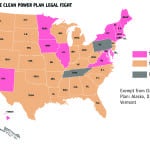Following the D.C. Circuit’s denial of motions for stay, 26 states have petitioned the U.S. Supreme Court to immediately block the Environmental Protection Agency’s (EPA’s) contentious Clean Power Plan from taking effect.
The January 26 application, directed to Chief Justice John Roberts Jr., notes that the states filed petitions for review of the carbon rule with the D.C. Circuit on the day the rule was published in the Federal Register “due to the immediate harm from the Plan.” But the federal court rejected motions for stay requested by the states and numerous industry groups on January 21, saying simply: “Petitioners have not satisfied the stringent requirements for a stay pending court review.”
The D.C. Circuit went so far as to order that consideration of the appeals “be expedited” so that a final decision can be issued before the rule’s compliance deadline passes.
Final state compliance plans or an initial compliance plan with a request for extension must be submitted to the EPA by September 6, 2016, and all completed final compliance plans must be submitted by September 6, 2018. The D.C. Circuit ordered that all parties submit the proposed format for the briefing of all issues by January 27. Oral arguments are scheduled for June 2.
But in their 63-page application, the states contended that the high court’s decision in Michigan v. EPA last June reversing the D.C. Circuit’s April 2014 judgment that upheld the EPA’s February 2012—finalized Mercury and Air Toxics Standards (MATS) “starkly illustrates the need for a stay in this case.” Because the rule had not been stayed during the years of litigation, the EPA assured its supporters that “the majority of power plants are already in compliance or well on their way to compliance,” the states said.
“In short, EPA extracted ‘nearly $10 billion a year’ in compliance from power plants before this Court could even review the [MATS] rule … and then successfully used that unlawfully mandated compliance to keep the rule in place even after [the Supreme Court] declared that the agency had violated the law,” they claimed.
The states seeking the Supreme Court’s stay are led by West Virginia and Texas, and include: Alabama, Arizona, Arkansas, Colorado, Florida, Georgia, Indiana, Kansas, Kentucky, Louisiana, Michigan, Mississippi, Missouri, Montana, Nebraska, New Jersey, Ohio, Oklahoma, South Carolina, South Dakota, Utah, Wisconsin, and Wyoming. Also petitioning the court are the Mississippi Department of Environmental Quality, Mississippi Public Service Commission, North Carolina Department of Environmental Quality, and the Oklahoma Department of Environmental Quality.
On January 27, a coalition representing the utility sector—including the American Public Power Association, a number of cooperatives, Georgia Power, Luminant Generation, Sunflower Electric, Tri-State Generation, and the Utility Air Regulatory Group—also filed a motion asking for a stay of the rule. Separately, the U.S. Chamber of Commerce, joined by fifteen other trade associations, also filed a supporting motion.
West Virginia Attorney General Patrick Morrisey on January 26 acknowledged that the stay request to the Supreme Court “isn’t typical at this stage of the proceedings.” But the states “must pursue this option to mitigate further damage from this rule,” he said in a statement.
Texas Attorney General Ken Paxton said it more starkly. “This power grab will force a massive reordering of nearly every state’s electric grid and result in less-reliable service for all customers,” he said. “Such far-reaching actions raise serious concerns about the power of the federal government.”
—Sonal Patel, associate editor (@POWERmagazine, @sonalcpatel)
Updated (Jan. 28): Adds details about motion in support of states by business association










